
GENERAL SADDLE INFRMATON
Hopefully you will find this western horse saddlery information helpful and of interest when you shop for top quality western saddles and tack made by leaders in the horse saddle industry: Simco, Longhorn, American Saddlery, Circle G Brand, Southern Riding, and Abetta. This is adpated from articles by Shelley Jessop and Don Blazer.

in Apison, TN:
 |
The Western Saddle
Introduction
Whether you participate in riding for pleasure or competition, few things are more important than having a saddle that properly fits both the horse and rider. Saddles can be compared to shoes; and we all know the discomfort associated with an ill-fitting, uncomfortable pair of shoes!
Designed for long hours in the saddle, the western saddle needs to be comfortable for both the rider and the horse. The wide flaps of the typical Western saddle distributes the rider's weight over a large area of the horse's back, making it more efficient and comfortable for the horse to carry its rider. The wide fenders keep the horse's sweat off the rider’s legs and the stirrups are wide enough to allow the rider’s feet to rest comfortably. The horn is used for roping cattle and provides an extra aid to rider for balance.
This article outlines the history of the western saddle, summarizes the main parts of a typical western saddle, describes the main types of western style saddles available, and provides basic guidelines for fitting a saddle.
The Evolution of the Western Saddle
(The evolution of the saddle write-up is on a separate page. Click the title.)
Modern Western Saddles
As time went on, saddle design continued to change to meet the needs of the working cowboy, the rodeo contestant, and the rider who was seeking a comfortable seat when heading down the trail for a pleasure ride. Saddles continue to be redesigned and redeveloped with “New and Improved” varieties appearing constantly.

The Hope Saddle by Carrico's Leatherworks of Edna, Kansas
(Historical Reproduction of an early western saddle)

Simco® Arabian Saddle

Longhorn® Show Saddle

Simco ® Roping Saddle

Simco ® Specialty Saddle

Synthetic Saddle by Abetta®
Parts of the Western Saddle
The Tree:
The foundation of the saddle is the tree. Today saddletrees are made of a choice of different materials. By far the best tree to go for is the "bull-hide covered wood" tree. This tree is made out of Ponderosa Pine with one or two layers of wet Bull-hide or rawhide stretched over it. As the hide dries it shrinks forming a vice-like covering. This makes for a very resilient and strong tree, which however has an element of "give" in it. Inferior trees are often covered with canvas or cheesecloth or poorer quality hides (e.g., goat) and are suitable only for light pleasure use. Saddletrees are also made out of molded fiberglass and other plastics but again these generally are suitable only for pleasure use and not for Ranch and Rope work. The tree consists of:
Bars:
The part of the tree that rests along the sides of the horse's spine is called the "bars." The size, shape and angle of the bars are what determine the fit. The three basic types of tree include the Quarterhorse (widest and longest bars, accommodating most "stock type" Quarterhorses), Semi-Quarterhorse (narrower bars, conforming to Thoroughbred type Quarterhorses), and Arabian tree (shorter bars, fitting shorter backed Arabian type horses). They should fit smoothly along the length of the horse's back and evenly distribute the pressure and weight of the rider and saddle. Both the length and angle of the bars affect how comfortably the saddle fits the horse.
Swell/Fork:
Also called the Pommel. Fork design gives shape and definition to the front of the saddle. An "A-Fork" is just what it's name implies; the front of the saddle looks like an "A" as it rises from the bars to the horn. Other fork styles are somewhat broader in appearance, with more swell to the fork. The more swell to the fork, the more support you feel.
Gullet:
The design of the swell/fork, as well as the angle of the bars, help to determine the width and height of the saddle gullet. This, in turn, affects how well a saddletree fits the horse's withers. The saddle must clear the withers. Too low a fit in this area and the horse can become sore quickly.
Horn:
This may be tall or short, thick or thin, and have a large horn cap or a small one. The angle used in attaching a horn to a tree also varies. The intended use for the saddle usually determines the horn design.
Cantle:
The term "high-backed saddle" refers to the cantle design used in the saddle tree. A higher-backed saddle can seem snugger in fit than a low one, given the seat measurement, simply because it offers more support in a higher position on the rider's back. This can come at a loss of flexibility for the rider so a lower cantle is often found in a roping saddle or when a quick dismount is needed such as in steer wrestling.

"Cuttin' Loose" by Billy Cook® Saddlery
Photo used with permission from the Simco/Longhorn Leather Co. Inc.
The Rigging:
Cinch (Front Cinch):
The cinch is the wide strap that fits under the horse to secure the saddle. Anywhere from 26”-36” long, cinches are often made of Mohair Blend material (usually 27 strands), Felt or Neoprene. The Latigo is attached to the cinch, and in turn tied to the Front Rigging Dee with a flat knot. Always secure the front cinch prior to the back cinch. Conversely, when unsaddling, undo the front cinch last.
Front Rigging Dee:
A metal ring to fasten the latigo through, which in turn is attached to the cinch.
Back Flank Billet (Rear Cinch):
The back flank billet should not hang down more than one inch when fastened, to prevent the horse's foot from becoming caught if scaling steep hills. A keeper strap should attach the back cinch to the front cinch under the horse's belly. The rear cinch is not used with all types of saddles.
Rear Rigging Dee :
A metal ring to fasten the back flank billet through.
Quick Change Buckle:
The quick change buckle is used to adjust the stirrup length.
Hobble Straps:
It is very important that hobble straps are used. This will prevent the stirrup from turning over if you fall off, which could result in your foot becoming stuck, in which case you risk being dragged!
Tie Strap Holder:
The tie strap holder is used to loop the excess length of the latigo through when saddled up. It is also used to loop the latigo through when storing the saddle to prevent the strap from dragging on the ground.
(Information provided in part by Western Horseman Magazine)
Types of Western Saddle
There are many styles of western saddles, depending on the purpose of the saddle. Some of the most popular types include:
Show:
Show saddles typically are intricately carved and often have a lot of silver. The style now is for a moderately built up seat in the front with a low cantle and a short fat horn.
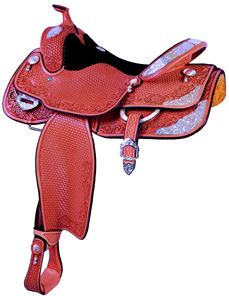
Longhorn® Benchmark Show Saddle
trimmed by Montana Silversmiths®
Trail & Pleasure:
Usually plainer than show saddles, they are made in a variety of horn, swell, seat, and skirt styles according to the needs of the rider. Trail and pleasure saddles are designed for trail riding with comfort and support in mind, not speed. Generally lighter in weight, a higher, slightly undercut fork assures a secure seat that is more comfortable for long rides. The cantle is higher than that on other saddles and it has a more pronounced dish. It has both a front and back cinch and is often equipped with a breast collar.
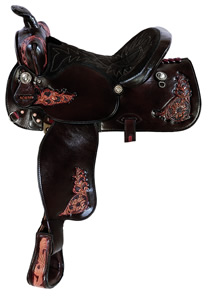

Salina's Supreme by Simco® Longhorn® Pleasure Saddle
Roping:
Roping saddles are built strong for demanding use. Usually on a bullhide covered tree, ropers have fairly tall, thick horns to "dally" the calf or steer to. They have a front and flank cinch, average size thick swells, and a low seat and cantle. They have deep, wide stirrups. Roper saddles are designed with a strong horn, tree and rigging so it will withstand roping. A low rounded fork, low cantle and a unique horn distinguish this saddle. The low front reduces leverage against the horn and the horse's withers and allows for freedom of movement for the rider. The Roping saddle has a low cantle and deep, wide stirrups. A front and back cinch is present.

Longhorn® Matt Tyler Roping Saddle
Cutters & Penners:
Built strong like ropers, cutters have tall thin horns and a very flat long seat. The fenders are often narrower than other saddles and have round stirrups, sometimes made of wood or metal. On saddles used as cutters and penners there is less rise in the seat with the lowest point a bit further ahead, making it easier for the rider to stay centered. The swells and horn are high so the rider can hang onto the horn at a proper angle to push or pull on it to remain stable. Cutters and penners generally flat seat that helps the rider move in the saddle in response to the horse's performance. The swells are wide and cut back, to allow the rider a tight grip when the horse turns sharply. Cutting and penning saddles possess both front and back cinches.
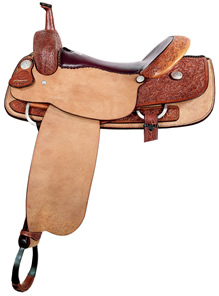
Longhorn® Super Star Cutting Saddle
Reining:
Reiners are designed to allow as much feel to the horse as possible. The horn is lower so it won't interfere with the rider's hands or reins. The seat is well shaped to allow the rider to roll their pelvis back for making those sliding stops. The reining saddle only has a front cinch, and not a back cinch.
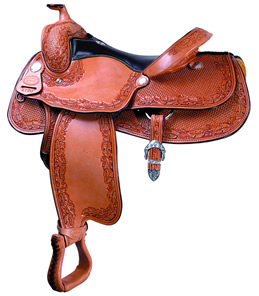
John Lyons®
Border Tooled Reiner
Barrel Racing:
Built with a low narrow horn often braided in rawhide, the barrel saddle has a deep seat and fairly wide swells to help keep the rider securely in the saddle. Barrel saddles used to always have a round skirt but the style preferred now is mostly square skirts. Barrel racers are designed for speed, comfort and safety, this saddle has a very deep seat so the rider stays put on fast runs and hard turns. The horn is higher, which makes it easier to hold onto around turns. It usually has a half-rough seat for extra grip. The fork is higher with wide swells for a tighter grip. The front is frequently built up for a secure seat and has good Dee rings or flat plate rigging for safety. Some barrel racers have moved to the "treeless" saddles, or if they do possess a tree it is made from a lightweight material, not the traditional rawhide covered wood tree. Barrel saddles usually possess only the front cinch and not a back cinch.
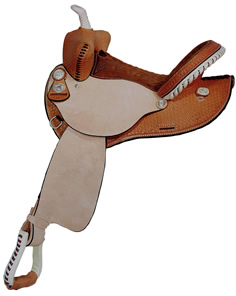
"WW"
Half Breed
by
Simco®
Arabian:
Designed to fit the unique features of the back of the Arabian horse, these saddles feature an "A" fork and often have rounded skirts and equitation seats (built up in front).
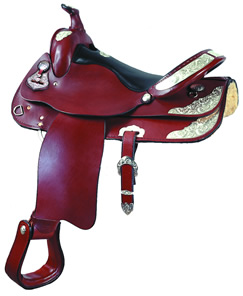
Simco® Musada Arabian Show Saddle
trimmed by Montana Silversmiths®
Rancher or "Old Time":
A resurrection of a saddle type popular in the 1800's, these saddles have roping horns, a "A" fork (no swells) and a hard leather seat, called a "slick" seat that joins the cantle abruptly, without the conventional cheyenne roll. The skirts can be either rounded or square and sometimes the stirrups leathers are on the outside of the fenders.
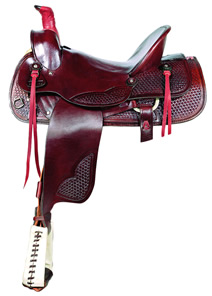
The A-Fork Old Timer by Simco®
Flexible Tree Saddles:
Although controversial, flexible tree saddles are becoming popular, particularly with Barrel Racers. The following is an excerpt from an article on the Tex-Flex Saddle, which outlines the basic theory behind flexible tree saddles:
This design is aimed at providing a truly flexible saddle built with a traditional look and feel. The challenge of creating a flexible saddletree was twofold. The first was a flexible tree bar that would conform to the horse's back. Experimenting with several different materials, this was achieved by bonding high-density polyethylene plastic and leather together to give flexibility while retaining structural integrity. A typical saddle seat is created by taking a preformed seat, or strainer, usually made of metal or fiberglass, and installing it onto the saddletree. The material for this seat had to be flexible, have shape-holding characteristics for the seat's foundation, and memory to bring the saddle back to it's original position. The answer came in the form of heat tempered spring steel.
The theory of the Flexible Tree Saddle is that a flexible bar can adjust to the conformation of the animal significantly widens the range of animals that will fit any particular tree design. The tree will move with the horse instead of against it. When a horse turns or bends his body the tree will "get out of the way" of the animal's shoulders and hips.
The materials used result in a thinner, lighter tree bar. Designers incorporated 1/2" neoprene rubber in the bottom layer of the skirt rather than an additional layer of leather, which enhances the comfort to the horse while providing close contact and less weight to the saddle. According to Tex Flex Saddles, the combination of these materials has the effect of putting the rider three times closer to the horse while providing even distribution of weight to the horse's back.
Selection and Fit of the Western Saddle
Proper saddle fitting is complicated and requires knowledge of
equine anatomy and saddle construction. It is the responsibility of the
rider to determine if and when a saddle is causing soreness. If the saddle
does not fit properly, there is no amount of padding that will correct
the problem. It is important to both fit the
rider to the saddle
and the horse to saddle.
It is difficult to select a saddle that will fit your horse without trying
it. It is crucial that you try the saddle on your horse, and ride with
the saddle, before you buy it. Note: This can easily result in the saddle
being marked and dirty, and The Saddle Zone cannot accept the return of
such a saddle (see our Return policy).
Saddle Selection
When it is time to start looking for your saddle, there are several main considerations to take into account before you begin:
Riding style:
What type of riding will you be doing? Have an idea of the type of saddle you are looking for before you start shopping around. Ensure that you have chosen a saddle that suits the style of riding you will be participating in.
Saddle fit and you:
Does the saddle fit you? A good fit saddle should feel very comfortable to sit in. Larger people will need a bigger seat; children and smaller adults will require a smaller, narrower seat for comfort. Saddle seats of children's saddles are 13” or less with adult saddle seats ranging from 14 - 18” (See image). Sit in the deepest part of the saddle and reach back. Place your hand flat on the seat. There should be one hand's width between the back of your seat and the cantle.

Photo used with permission from
Cheryl McNamee www.equusite.com
Saddle fit and your horse:
Does the saddle fit your horse? This is very important!! And it is not an easy task to determine the proper fit. It is best to have an expert help you out when you are testing saddles. Once you have a potential saddle in hand, ask yourself the following questions.
![]() Are the Bars the right length and angle for your type of horse?
There should be no rubbing on the hipbones. (See Parts of The Western
Saddle: The Tree: Bars).
Are the Bars the right length and angle for your type of horse?
There should be no rubbing on the hipbones. (See Parts of The Western
Saddle: The Tree: Bars).
![]() Is the saddle level on the horses back? Place it on the horse first
without the pad. Jiggle the saddle with the horn. It should slide into
position with the cinch falling vertically, about an inch behind the horses
elbow. Look at the skirt, is should not slope up or down. The seat where
you will be sitting should be level.
Is the saddle level on the horses back? Place it on the horse first
without the pad. Jiggle the saddle with the horn. It should slide into
position with the cinch falling vertically, about an inch behind the horses
elbow. Look at the skirt, is should not slope up or down. The seat where
you will be sitting should be level.
![]() Does the pad clear the saddle? Saddle up with the pad. The pad
should clear the saddle on all sides by a couple inches. It should be
thick enough to provide cushion. When testing saddles, use the pad that
you will actually be riding with.
Does the pad clear the saddle? Saddle up with the pad. The pad
should clear the saddle on all sides by a couple inches. It should be
thick enough to provide cushion. When testing saddles, use the pad that
you will actually be riding with.
![]() Can you slide 2-3 fingers sideways under the gullet? More room
indicates the bars are too narrow, less room indicates the bars are too
wide.
Can you slide 2-3 fingers sideways under the gullet? More room
indicates the bars are too narrow, less room indicates the bars are too
wide.
![]() Can you slide a flat hand under the saddle on both sides of the
withers? The saddle should not hit the withers, but rest behind the shoulder.
Can you slide a flat hand under the saddle on both sides of the
withers? The saddle should not hit the withers, but rest behind the shoulder.
![]() Does the saddle sit securely? The saddle should fit securely, even
without the cinch's being done up. The saddle should not rock very easily
from side to side even when the front cinch is undone.
Does the saddle sit securely? The saddle should fit securely, even
without the cinch's being done up. The saddle should not rock very easily
from side to side even when the front cinch is undone.
![]() How does the saddle fit after riding for about 15 minutes or so?
Ride, then dismount and recheck the fit. Trot and canter for at least
15 minutes, dismount and recheck the fit again.
How does the saddle fit after riding for about 15 minutes or so?
Ride, then dismount and recheck the fit. Trot and canter for at least
15 minutes, dismount and recheck the fit again.
![]() Is your horse exhibiting any type of behavioral problems while
test-riding the saddle? Pinning his ears, bucking, nipping at his sides
or any other unusual behavior may indicate a problem with saddle fit.
Is your horse exhibiting any type of behavioral problems while
test-riding the saddle? Pinning his ears, bucking, nipping at his sides
or any other unusual behavior may indicate a problem with saddle fit.
![]() What kind of condition is the saddle in? Make sure your saddle
is safe. Check for wear, damage or faulty construction. Are the stirrup
hobble straps present? Is there a keeper to attach the front and back
cinches? String can be used temporarily. Plan on replacing, repairing
or adding additional pieces as required.
What kind of condition is the saddle in? Make sure your saddle
is safe. Check for wear, damage or faulty construction. Are the stirrup
hobble straps present? Is there a keeper to attach the front and back
cinches? String can be used temporarily. Plan on replacing, repairing
or adding additional pieces as required.
Note: Keep in mind that fit of your saddle will change based on your horses age and condition. Be aware of the changes in your horses form and adjust your tack accordingly. The perpetual squeak of a new saddle until it is broken in is a myth; squeaking indicates that the saddle is made from poor quality leather. There should be very little, or no squeak at all, even with a brand new saddle.
Price:
What can you afford? Having a custom made saddle is the ideal. The bare tree can be fit to the horses back prior to the saddle being built, ensuring a good fit. But, due to the cost involved, it is beyond the reach of many people. As the old saying goes “You Get What You Pay For”. Establish your price range and then get the best quality saddle for the best price. We are confident that you will do just that here at The Saddle Zone. Ensure you have a feel for the price range of similar saddles. Consult with your expert to ensure you are being charged a fair price.
Experience:
Do you have enough experience to choose your own saddle? There are a countless variety of saddles on the market. It can be overwhelming, particularly if you are a new rider with limited experience. Recruit an expert to help you evaluate saddles and to assist you with selecting the appropriate one for you and your horse. Even if you do have some experience, it is always a good idea to get someone else's opinion. An experienced and reputable horse-person, saddle maker or trainer are all good candidates.
Conclusion
A saddle is a very important aspect of the total experience for both the rider and horse, in addition to being a substantial investment. Take the care and time to select the right one. Remember, a good saddle will last a lifetime providing the rider and horse with comfort for blissful hours of riding!
